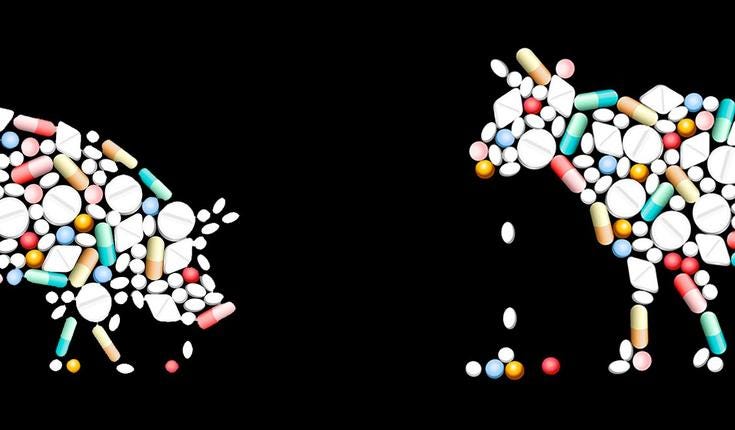💊 Finding the path of least antibiotic resistance
Welcome back to The Regeneration Weekly, a newsletter delivering regenerative food and agriculture news to your inbox every Friday. Not a subscriber yet?
Health: Since the discovery of penicillin in 1928, antibiotics have played a critical role in protecting public health by killing or inhibiting the growth of dangerous bacteria. But from the earliest days of the ‘antibiotic era,’ drugs like tetracyclines, penicillin, and tylosin have been approved for parallel use in livestock destined to become food. It is worth recognizing that sales of “medically important” antibiotics for use in animal agriculture have dropped 25 percent since 2010. Unfortunately, the National Resources Defense Council (NRDC) estimates that 65 percent of the antibiotics sold in the US are for animal agriculture. Since a peak in 2015, ag sales of antibiotics were gradually decreasing. But a new Food and Drug Administration (FDA) report concludes that overall sales are ticking up for the second year in a row - driven by a 9 percent increase in pork production and a 1 percent increase in beef production.
While antibiotic use may seem like a new issue, the drugs have been used in agriculture since 1950 to help livestock with:
Treatment & Prevention: The lack of activity paired with unsanitary conditions in concentrated animal feeding operations (CAFOs) compromises animals’ immune systems - leading to respiratory diseases (i.e., dust pneumonia and heat stress) and liver abscesses caused by high grain diets. Rather than shift the flawed protein production model, antibiotics are incorporated into animal feed and water to treat illnesses and outbreaks. And many industrial livestock producers give healthy animals small doses of antibiotics on a daily basis to prevent illness in overcrowded, stressful conditions. This technique, otherwise known as subtherapeutic antibiotic therapy (STAT), has also made it irresistible for CAFOs to pack more livestock into cramped facilities - even as the practice threatens to breed “superbugs” and diminish the effectiveness of drugs in the human population.
Growth Promotion: CAFOs are guilty of overusing antibiotics not to treat or prevent disease but to lower fodder costs and increase animal protein production. By killing off certain bacteria in the animals’ guts, antibiotics make more of the energy in the food available for the animals themselves. In short, the drugs allow livestock to rapidly convert food into muscle. In 2017, the FDA implemented Guidance for Industry #213 - restricting antibiotics for production purposes (i.e., growth promotion), which accounted for 15 percent of livestock drug use. However, the restriction fails to address antibiotic use for disease prevention - allowing CAFOs to use the same drugs to promote general health.
Nowadays, it is nearly impossible to decouple the misuse of antibiotics in animal agriculture from the emergence of antimicrobial resistance (AMR) - the ability of bacteria or other microbes to resist the effects of a drug after being exposed to them. As more antibiotics are used, especially for long periods of time in low doses in cramped CAFO conditions, they can mutate to resist those drugs. The new resistant bacteria can then be passed from animals to humans via the animal products themselves, feedlot workers, and the environment (i.e., animal waste or wastewater) - making drugs used to treat people infected with those bacteria useless. A 2019 Centers for Disease Control report found that AMR causes 2.8 million infections and 35,000 deaths annually in the US. Moreover, AMR costs our country $55 billion every year ($20 billion for health care and $35 billion for loss of productivity).
In 2020, the World Health Organization (WHO) identified AMR as one of the biggest threats to global health. By 2050, the frequent use of antibiotics to promote animal growth threatens to initiate a post-antibiotic era, which will cost the global economy up to $100 trillion - causing nearly 10 million deaths per year. In this not too distant future, simple surgeries could be too risky to attempt, and common diseases - respiratory tract infections, urinary tract infections, etc. - could be untreatable. Just like with humans, the increase in AMR will make animal treatments ineffective and render infections fatal. And if trends in AMR don’t slow, there will be an 11 percent drop in livestock production within the next thirty years.
While consumers can try and control their own exposure to antibiotics, systems-level reform is necessary. Beyond policy reform, producers must stop relying on antibiotics to maximize output and cover up flaws in the system rather than fix the system. Since many critics claim that it’d be too expensive to implement natural methods for protecting animals from disease - e.g., enlarging barns to reduce crowding - at scale, a new wave of companies are launching non-antibiotic products that can prevent disease and improve feed conversion. Ocean Harvest Technology, for instance, markets a seaweed-based additive that reduces antibiotic use while Pando Nutrition and ProAgni are commercializing pre- pro- and postbiotics that promote a healthy animal microbiome. In doing so, livestock producers can keep the benefits of antibiotics without harming the animal, the environment, or human health.
The only way to slow the emergence of drug-resistant bacteria is by using antibiotics conservatively. But the blanket application of drugs for industrial livestock production unabashedly violates this rule. With the recent change in administration, organizations are calling for Biden to act on the AMR crisis. It is imperative that we set a national target to reduce antibiotic use in livestock, establish a system to track data on AMR, and ensure that producers accurately report their on-farm antibiotic use. Meanwhile, the increase in regenerative, grass-fed beef finishers can show US consumers that livestock can be raised without large amounts of drugs.
Watch: Using microscopic footage, harrowing personal stories, and expert insights RESISTANCE clarifies the problem of antibiotic resistance, how we got to this point, and what we can do to turn the tide. In talking-head interviews with experts, the documentary explains the fundamental reason why the overuse of antibiotics is so dangerous: Every time we use antibiotics, we give bacteria another chance to develop resistance to it. Director Michael Graziano goes one step further by exploring what the future of medicine might look like without antibiotics.
Shop: Yolélé was founded in 2017 to create economic opportunities for smallholder farming communities; to support regenerative food systems, and to share Africa’s ingredients and cuisines with the world. The company’s inaugural ingredient, fonio, is a tiny, gluten-free ancient grain sourced from farmers (mostly women) in one of the world's most vulnerable places: the West African Sahel. Yolélé is on a mission to create a global market for traditional climate-smart crops like fonio, which are grown in a silvo-agro-pastoral system that regenerates soils without chemical inputs or groundwater-depleting irrigation. Their products are available for purchase at yolele.com, Amazon, Whole Foods, and more. And you can subscribe to the Yolélé newsletter for a free 10 oz bag of fonio OR fonio pilaf with your next purchase of $32 or more.
Disclaimer: The Regeneration Weekly receives no compensation or kickbacks for brand features - we are simply showcasing great new regenerative products.
The Regeneration is brought to you by Wholesome Meats | Soilworks | PastureMap.






